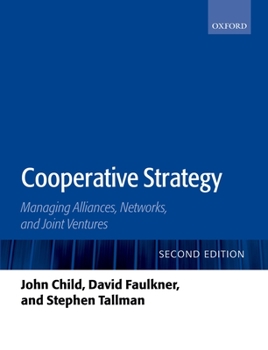Cooperative Strategy: Managing Alliances and Networks
Select Format
Select Condition 
Book Overview
Cooperation has become the leading strategy adopted by business and other organizations. It is taking on new forms that are adapted to changing market expectations and technological possibilities in the rapidly evolving business environment. This new edition of Cooperative Strategy provides a comprehensive view of the practical and theoretical literature concerning cooperative strategies, and the alliance and network organizational forms that are the enablers of these strategies. It takes the reader through the stages of developing a cooperative alliance, from choosing a cooperative form and selecting partners, to establishing an alliance and managing the process of cooperation. It examines cooperative strategies in different sectors as well as internationally, and discusses performance criteria and evolution of cooperation over time. With insights from internationally recognized experts on cooperative strategy, this book presents extensive research on the topic while also addressing practical issues of alliance management.
Format:Paperback
Language:English
ISBN:0199266255
ISBN13:9780199266258
Release Date:December 2005
Publisher:Oxford University Press, USA
Length:472 Pages
Weight:2.00 lbs.
Dimensions:1.1" x 7.4" x 9.6"
Customer Reviews
1 rating
2nd Edition Add more practical detail
Published by Thriftbooks.com User , 19 years ago
Strategies Of Cooperation: Managing Alliances, Networks, And Joint Ventures 2nd Edition by John Child, David Faulkner (Oxford University Press) excerpt: Strategic alliances and other forms of interfirm cooperation have grown remarkably since the mid-1980s. They are one of the more important new organizational forms. Despite the managerial and organizational challenges they undoubtedly present, there is no sign that alliances are a transient phenomenon. A survey based on 323 questionnaire responses and over 400 interviews with senior executives in 2000 indicated that alliances were `expected to account for 16 percent to 25 percent of median company value within five years and, astonishingly, more than 40 percent of market value for one-quarter of companies' (Contractor and Lorange 2002: 4). Alliances are, along with outsourcing and virtual value-chains, one of the defining forms of modern networking among firms. As noted, they represent a clear break away from the internalized, hierarchical model of the firm, of which General Electric and IBM were salient examples in the 1980s. Today, leading corporations such as these have as many as 1,000 alliances. In the past, such corporations might have regarded alliances as a relatively peripheral activity, primarily for entering emerging country markets in which risks were high or government regulations required jVs or licensing agreements. Today, alliances are regarded as a means to achieving fundamental strategic objectives such as a strong market position, significant knowledge acquisition, and major cost reductions. This book attempts to take stock of current thinking on the subject of cooperative strategy. The focus will he on cooperation between firms, though many of the insights into establishing and managing interfirm cooperation can also be applied to partnerships between other types of organization. Alliances, which are partnerships between firms, are the normal agent for cooperative strategy. "they are often `strategic' in the sense that they have been formed as a direct response to major strategic challenges or opportunities which the partner firms face. Alliances are a means to an end, and consequently they are not necessarily formed with a long-term cooperative relationship in mind. But they may be established with this intention, the more so when the partners invest substantially in them. Once alliances are up and running, partners may also perceive unanticipated benefits from cooperation, such as mutual learning, which lead them to reevaluate it positively. However, alliances can also be formed with shorter-term objectives in view. A firm may intend to use an alliance as a means of appropriating competencies and knowledge from its partner, which it continues to regard as an actual or potential competitor. Or it may enter into an alliance as a way of taking out an option for the future in conditions of uncertainty-for example, entering an unfamiliar national market. Once it has mastered the





